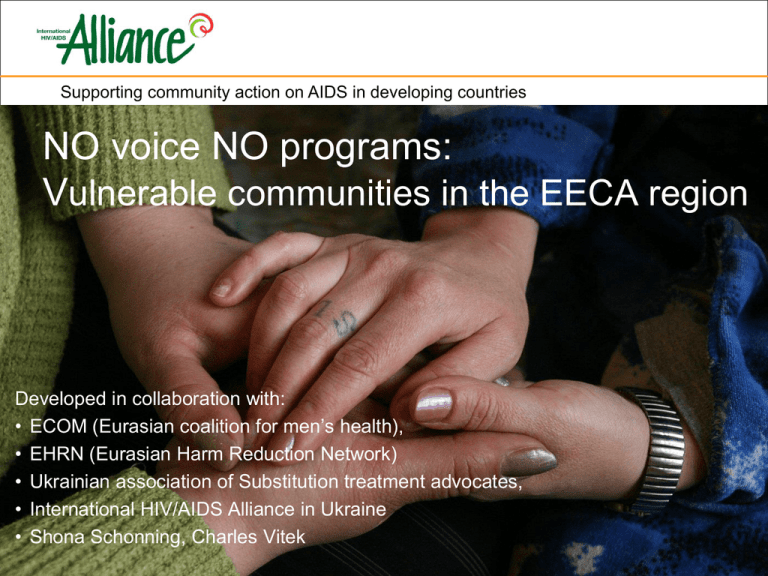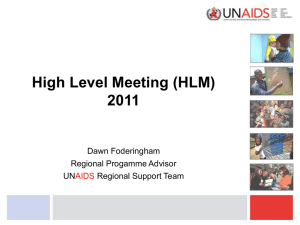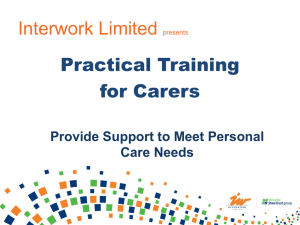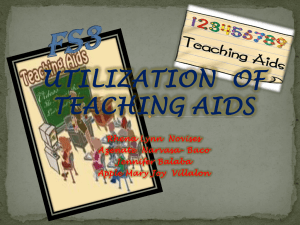
Supporting community action on AIDS in developing countries
NO voice NO programs:
Vulnerable communities in the EECA region
Developed in collaboration with:
• ECOM (Eurasian coalition for men’s health),
• EHRN (Eurasian Harm Reduction Network)
• Ukrainian association of Substitution treatment advocates,
• International HIV/AIDS Alliance in Ukraine
• Shona Schonning, Charles Vitek
Supporting community action on AIDS in developing countries
Presentation outline
1. Explosive epidemics among MARPs
2. Political commitments have been made… but
3. Coverage not enough for impact
4. Limited investments and policy space for MARPs
5. Conclusions
Supporting community action on AIDS in developing countries
Explosive epidemics among MARPs
Supporting community action on AIDS in developing countries
HIV prevalence among IDUs (2006): data from
routine serum monitoring (RS) and sentinel
surveillance (SS)
18,34
Cherkassy
7,88
Kherson
5,90
Summy
Simferopol
SS
18,40
18,00
14,55
49,20
13,33
Poltava
62,80
15,02
Odessa
54,70
22,69
Nikolaev
46,00
18,96
Lutsk
37,60
38,32
Kiev
16,42
Donetsk
Vinnitsa
10
International AIDS Alliance, Ukraine
20
61,20
34,80
15,49
0
RS
34,80
6,56
Kharkov
29,00
48,70
30
40
HIV prevalence, %
50
60
70
Supporting community action on AIDS in developing countries
Routes of transmission, reported HIV cases,
Russia 1987 - 2008
100%
90%
IDU
80%
70%
50%
40%
Hetero- sexual
30%
20%
10%
2008
2007
2006
2005
2004
2003
2002
2001
2000
1999
1998
1997
1996
1995
1994
1993
1992
1991
1990
1989
1988
0%
1987
% случаев
60%
Парентеральный контакт при употреблении наркотиков
Заражение матерей от детей при грудном вскармливании
Заражение детей от ВИЧ+ матерей во время беременности, родов и грудного вскармливания
Пребывание в нозокомиальном очаге
Переливание инфицированной ВИЧ крови
Гетеросексуальный контакт
Гомосексуальный контакт
Source: Russian Federal AIDS Center
Underreporting of IDU status
• Majority of women report heterosexual risk but IDU is
underreported
• Hepatitis C is a marker for IDU exposure
• Substantial minority of HIV+ women deny IDU but are
hepatitis C+
• In PMTCT in St.
Petersburg,
25% - 40% of
´non IDU´ HIV+
women are
hepatitis C+
Political
commitments have been made…
Supporting community action on AIDS in developing countries
PLHA and IDU community representative speaks to UNGASS Delegates
Supporting community action on AIDS in developing countries
Political commitments have been made…
UNGASS Declaration(2001, 2006)
Dublin Declaration on Partnership to Fight HIV/AIDS in
Europe and Central Asia (2004)
Vilnius Declaration on Measures to Strengthen
Responses to HIV/AIDS in the European Union and in
Neighboring Countries (2004)
Bremen Declaration Responsibility and Partnership –
Together Against HIV/AIDS (2007)
A call to regional governments to act now
Coverage not enough for impact
Supporting community action on AIDS in developing countries
Men who have sex with men in Eastern Europe: who are they being reached by?
Supporting community action on AIDS in developing countries
Affected communities are showing the way…
• Association of substitution treatment advocates in Ukraine
(ASTAU) has grown rapidly and built leadership and advocacy skills
focused on the protection of rights for medical help for SMT.
• “Vstrecha” provides HIV prevention services for MSM in Belarus and
refers to specifically trained public health services in the 8 largest cities.
• The information center GenderDoc-M in Moldova is the only
organization in the country that deals with protection of rights of sexual
minorities.
• The community center PULSAR-Omsk has done innovative work with
MSM and the Russian Federation
• All Ukrainian PLHA Network
• Alliance Ukraine
Supporting community action on AIDS in developing countries
Limited Data on MSM HIV/STI prevention coverage
Supporting community action on AIDS in developing countries
Prevention programs coverage in
EECA could not impact
• There no coordinated data on coverage in the region
but clear that very few countries have sufficient
(around 60%) coverage of drug users with
comprehensive package of services.
• Where there is, it does ultimately lead to impact on
HIV prevalence among younger IDU group.
Supporting community action on AIDS in developing countries
Newly detected HIV cases among IDUs and % of
young users among IDU cases, Ukraine 2000 - 2008
International AIDS Alliance, Ukraine
Supporting community action on AIDS in developing countries
Comprehensive programs for IDUs are needed
Comprehensive package
of services for IDUs
including harm reduction,
substitution therapy and
access to testing and
treatment of HIV need to
be introduced in ALL
countries.
Supporting community action on AIDS in developing countries
Limited investments and policy space for MARPs
Supporting community action on AIDS in developing countries
Political commitments are not leading
to state support of programs
• Only in the last 3 years have comprehensive services for
MARPS been explicitly included into state strategies and
national AIDS programs
• Stigmatization of vulnerable communities still the main
issue which is not addressed.
• Even where MARPS are included in state programs or
strategies, prevention and treatment programs for IDU,
FSW, MSM, street children hardly get budget allocations.
Supporting community action on AIDS in developing countries
Millions
Total HIV spending GR 2010, last year reported - EECA w/o Russia
120
100
80
USD
Global Fund
All other International
National budget
60
40
20
0
Ukraine Kazakstan Belarus Uzbekistan Republic ofKyrgyzstan Georgia
2009
2009
2009
Moldova
2009
2009
2008
2009
Source: UNAIDS
Last year reported
Tajikistan Azerbaijan Armenia
2009
2009
2009
Supporting community action on AIDS in developing countries
HIV spending by source in EECA:
GFATM funds complement national investment but some
countries still dependent on donors
100%
80%
60%
40%
20%
0%
Таджи
кистан
Кыргыстан
Грузия
Source: UNAIDS
Армения Республика Болгария
Молдова
Украина
State
Азербай
Джан
Беларусь Казахстан Хорватия Российская Румыния
Федерация
International
Латвия
Supporting community action on AIDS in developing countries
HIV spending categories per financing source:
Donors spend more on prevention
100%
8. Research excluding operations research which is
included under
90%
7. Enabling Environment and Community
Development
80%
6. Social Protection and Social Services excluding
Orphans and Vulnerable Children
70%
60%
5. Incentives for Human Resources
50%
40%
4. Program Management and Administration
Strengthening
30%
3. Orphans and Vulnerable Children
20%
2. Care and Treatment
10%
1. Prevention
0%
Public
International
Source: UNAIDS
Supporting community action on AIDS in developing countries
HIV profile of spending in EECA - GR 2010 last year reported
Prevention spending in EECA - GR 2010 last year reported
Millions USD
Profile of
HIV
spending:
Only 11%
on MARPS
though
they are
the majority
of those in
need!
600
Prevention programmes
for sex workers and
their clients
2%
500
Programmes for men
who have sex with men
1%
400
Harm-reduction
programmes for
injecting drug users
8%
300
200
100
0
Prevention
(sub-total)
Source: UNAIDS
Care and
Treatment
(sub-total)
Orphans and
Vulnerable
Other Prevention
Children
(sub89%
total)
Program
Management
and
Administration
Other
Supporting community action on AIDS in developing countries
Finance in EECA Key characteristics
• Big increase in funding since UNGASS (over a billion
spent on HIV)
• GFATM funds stimulate national funds
• Underinvestment in prevention (especially from
national funds)
• Gross underinvestment in programs targeting mostat-risk populations
• Money wasted on high pharmaceutical prices
• Most-at-risk populations and PLHIV may be
penalized by GFATM eligibility criteria
Supporting community action on AIDS in developing countries
Conclusions
• Open and participatory approach to program planning and
budgeting on national level should be further supported
• Targeting resources specifically for MARPs in state budgets
and donors supported programs.
• Supporting of community voice in decision making bodies
on national and regional level
• Sustainable programs for communities could be started
only if community systems in EECA will be supported






